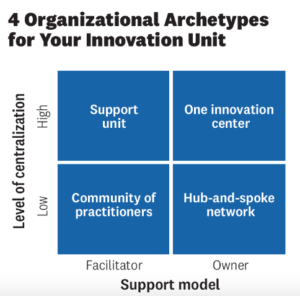Innovation has become a keyword in modern business and education. What’s the next innovative product on the market? What’s the next disruptive technology to break through? And how do we get there? In this post we’ll examine four different organizational archetypes for your businesses innovation unit.
The framework is broken down into two basic concepts. First is the level of centralization. Is the innovation centre located closely to the head office? Is there just one building with employees from different disciplines working together to innovate? Or are there a network of employee’s or other consultants?
On the other hand, is the Innovation Unit used as more of a support system within the company, or do they operate as a separate unit with more control over the innovation process, budget testing, staff and budget? There is no one quadrant that is better than another, but knowing how to setup and operate an Innovation Center can greatly mitigate risks of lost time, money and resources.

We’ll examine each quadrant of this framework:
Support Unit: The central support unit tends to have low staff, be low budget and in charge of training or developing guidelines to govern innovation. This is usually a relatively small unit and is often seen in corporations with multiple business units that have strong autonomy.
Community Of Practitioners: Employees within the business have a specific job, but are trained and certified in innovation to run projects, coach methods or facilitate innovation events. Intuit overhauled it’s methodology of how the company operates together in 2008. Corporate leaders recognized they needed to change the way they were working as a company, to create innovative product offerings that satisfy their customers, rather than just incrementally improving their products to make them easier. The strategic goal was to “form a globally disbursed, cross-functional team of innovation experts, who would be champions for innovative activities and drive cultural change across the organization over time”. This was done by training employees to become Innovation Catalyst. Over time, Intuit made the Forbes list of most innovative companies and currently sits at #51.
One Innovation Centre: In these buildings, companies host spaces for think tanks, idea generation and innovation. Bringinging together people, technologies, skills and resources from within and outside the company under the same roof, they are meant to accelerate innovation projects. Google X Research Lab is an example of an innovation. Despite being centralized and owned directly by Alphabet (Google’s parent company), it operates as a separate organization. X is described as “an area where regular investigation into the absurd is not just permitted but encouraged, and even required.” It has tried and abandoned projects such as hoverboards and creating fuel from seawater, and has succeeded in projects such as a contact lense that measures glucose levels in a diabetic person’s tears.
Hub and Spoke Network: This model is a more decentralized version where centers are placed strategically around the world, in so called hot-spots. This version is often capital heavy and used my big multinational companies. An example of this is Johnson & Johnson who introduced JLABS in 2012. There are six JLABS worldwide are incubating about 140 companies which are granted access to everything from J&J’s compound library to its commercial and regulatory experts. The model is known as “no-strings attached” because the companies they are funding to not have to sign a licensing agreement with J&J.
Despite this framework being a solid outline to describe the different types of innovation initiatives used across businesses, an organization may take bits and pieces to create their own strategy. For example, Google’s passion project allowed employees to use 20% of their time to focus on a side project that was of interest to them. Passion projects spawned creations such as Gmail and Google Maps.
The four organizational archetypes are just a brief outline of strategies that organizations use to set up and manage an innovation strategy. Ultimately one or a combination of these can help your organization reach their innovation goals.

